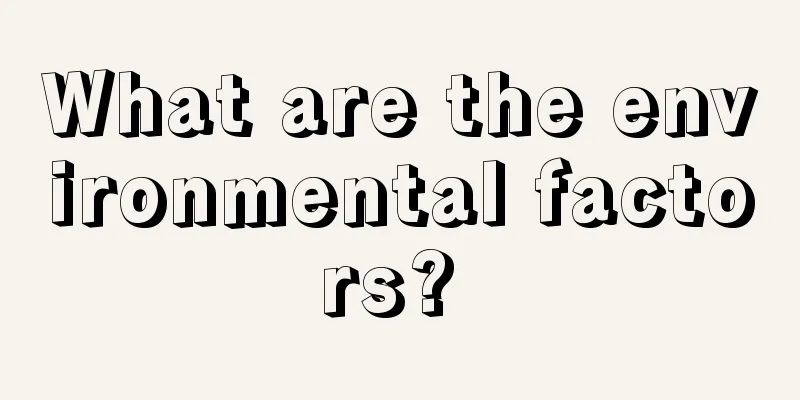What are the environmental factors?

|
People say that environment can change a person. What does the so-called "environment" refer to? Many people are confused and don’t understand what counts as the environment. In fact, the environment includes a lot, such as the real environment and the cultural environment. The quality of the environment may affect people’s hearts, but if people have strong willpower and self-awareness, they will not be affected by the surrounding environment. What are the environmental factors? Let’s take a look at it next. 1. Three states of environmental factors When identifying environmental factors, three states of environmental factors should be considered: normal, abnormal and emergency. The identification of environmental factors should not only consider "normal" situations, but also abnormal situations such as machine maintenance, as well as emergency situations such as fire and explosion. (1) Normal state Under daily production conditions, environmental problems may arise. (2) Abnormal status Environmental problems that are significantly different from normal conditions and occur during foreseeable situations such as startup/shutdown, shutdown, and maintenance. For example, a large amount of sewage is discharged when boilers and generators are started; impure incoming materials lead to a sharp increase in local sewage discharge; high-concentration waste liquid is generated when factories regularly overhaul and clean equipment, etc. (3) State of emergency Such as environmental factors caused by emergencies such as fire, flood, explosion, facility and equipment failure, large-scale leakage, typhoon, earthquake, etc. For environmental factors that may exist in foreseeable emergencies, corresponding measures and plans should be in place to ensure that their environmental impact is minimized. If a region is threatened by floods every year, then when evaluating environmental factors, it is necessary to give comprehensive consideration to the environmental factors in this emergency state and formulate emergency systems and measures. 2. Three tenses of environmental factors When identifying environmental factors, consider the three tenses of environmental factors: past, present, and future. When identifying environmental factors, organizations should not only consider the "current" situation, but also look at environmental problems left over from the past and environmental problems that will arise in the future. (1) Past: Environmental problems left over from the past or environmental accidents that occurred in the past. For example, although the factory uses brand new equipment, it also occasionally uses old equipment. If the old equipment is not properly maintained, the waste oil generated may pollute groundwater; chemical leaks that have occurred in the past, etc. (2) Present: The organization’s existing, present environmental problems. (3) Future: Environmental problems that may arise in the organization’s future. Such as the environmental problems that may be caused after the product leaves the factory; the disposal of the product when it is scrapped, the environmental problems that may be caused by future laws, regulations and other requirements and activities in their change plans; the environmental problems that may be caused by the introduction of new projects, new products and process modifications. 3. Seven types of environmental factors Seven types of environmental factors, that is, seven manifestations of environmental factors. There are seven types of environmental factors that should be considered when conducting environmental factor identification. (1) Atmospheric emissions Such as waste gas (mainly carbon dioxide, sulfur dioxide, fluorine oxides), smoke, etc. produced by boiler combustion. (2) Discharge into water bodies Domestic sewage discharge and industrial wastewater discharge. (3) Waste disposal Such as the disposal of toxic and hazardous wastes such as oily rags and waste residues. (4) Land pollution Such as oil and chemical leakage. (5) Impact on the community Such as noise, etc. (6) Consumption of raw materials and natural resources (7) Other local environmental issues Such as ecological environment destruction, electromagnetic pollution, ground subsidence, etc. |
<<: What are the main factors that affect climate?
>>: How to identify the authenticity of medical stone pot
Recommend
How about minimally invasive interventional treatment for advanced liver cancer? The effect is very good
With the continuous improvement of medical standa...
Lily and pear rock sugar water has many benefits
Lily is a food ingredient that is deeply loved by...
Which has less side effects, radiotherapy or chemotherapy for lung cancer? Analysis of the difference between radiotherapy and chemotherapy for lung cancer
Cancer is a malignant tumor. In the process of tr...
Does an enlarged liver necessarily mean liver cancer?
An enlarged liver is a common sign of liver cance...
How to treat retroperitoneal lymphoma
The harm caused by retroperitoneal lymphoma is re...
Will you definitely die if you get skin cancer?
Will you die if you get skin cancer? Skin cancer ...
What are the dangers of endometrial cancer
What are the hazards of endometrial cancer? Many ...
What is the clinical significance of creatinine clearance
Creatinine is a metabolic product of creatine. Cr...
Will amblyopia lead to blindness?
Amblyopia is a problem that we cannot ignore, bec...
Most early-stage kidney cancers can be cured
One of the most prominent early symptoms is hemat...
Symptoms of early pregnancy: pain in the right lower abdomen
Being pregnant is a very happy thing and a big ev...
Will early tongue cancer affect life expectancy?
For many people, it is a blessing to reach their ...
What are the common ovarian tumors? Do you know about common ovarian tumors?
Ovarian tumors are a very common and high-inciden...
The simplest way to make mutton soup
Winter is the best time to drink mutton soup, bec...
How should rheumatoid arthritis be treated?
Rheumatoid arthritis is a joint disease that many...









